How To Avoid Contaminant Rebound At Sites With Groundwater Contamination
Treat the source, not the symptom! Over the past 30 years, groundwater remediation technologies and strategies have changed, yet post-treatment contaminant “rebound” is still a problem at many sites.
First, pump and treat gave way to air sparging. Then, the rage was aerobic bioremediation using oxygen-release products – which more recently gave way to in-situ chemical oxidation (ISCO) methods based on more aggressive active-oxygen chemistries. Regardless of the technology used, the rebound effect is still a problem. Is this a failure of the technology? Or is rebound an artifact of our limited understanding of contaminant distribution in the subsurface? More often than not, it’s the latter.
Typically, the underlying issue is an over-estimate of the importance of the aqueous-phase (dissolved) mass present in groundwater, and an under-estimate of the so-called “sorbed” mass – i.e., the non-aqueous mass trapped within the solid matrix of the subsurface geology. Based on EWMA’s evaluation of the cumulative data from past investigation and in-situ remediation projects, it has become clear that the vast majority of the contaminant mass – particularly petroleum hydrocarbons and chlorinated solvents — is present in the sorbed-phase, which can account for more than 99% of the total mass. Unless and until the 800-lb. gorilla of sorbed-mass is accounted for at your site, the latest, greatest technology may still “fail,” and contaminant rebound in groundwater may be just a matter of time.

For more information about our cost-effective and innovative bioremediation strategies, please contact our one of our senior bioremediation expert Dave Fullmer at david.fullmer@ewma.com or 973-560-1400 ext.191.
